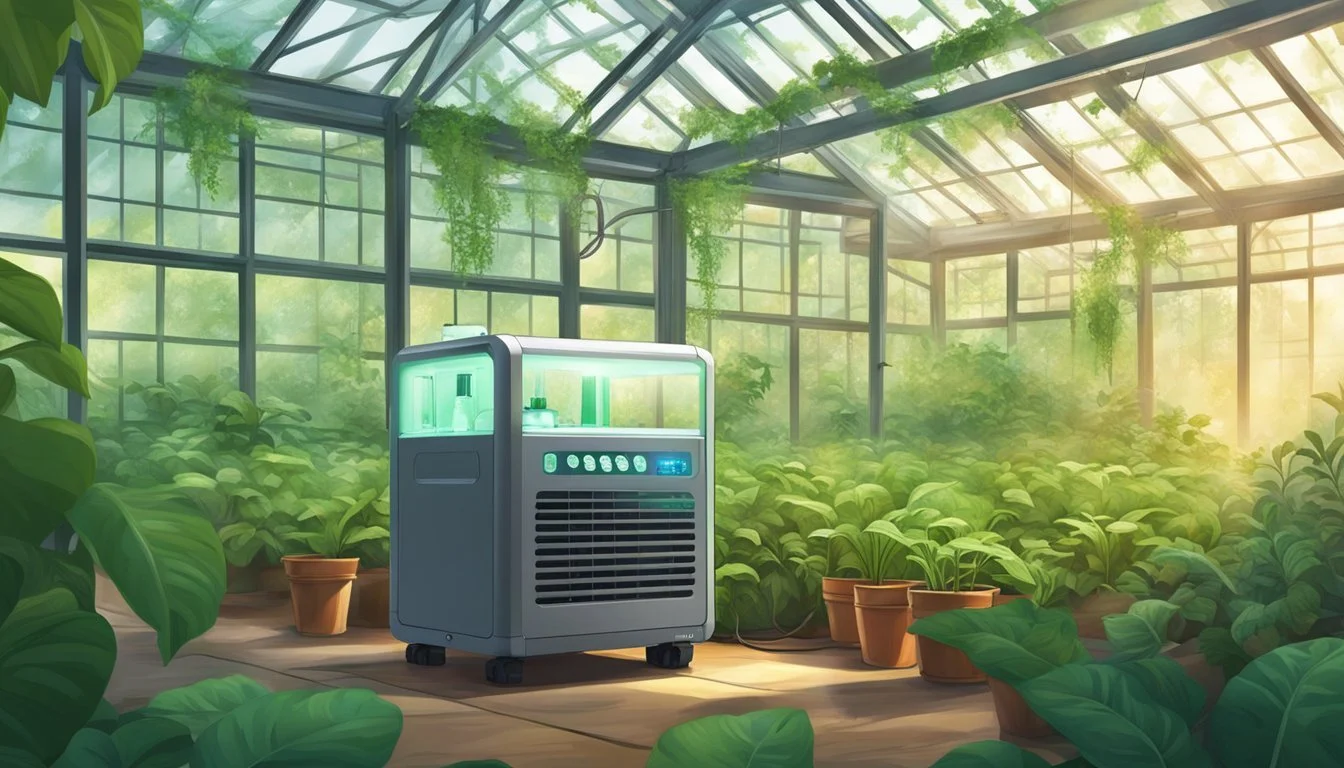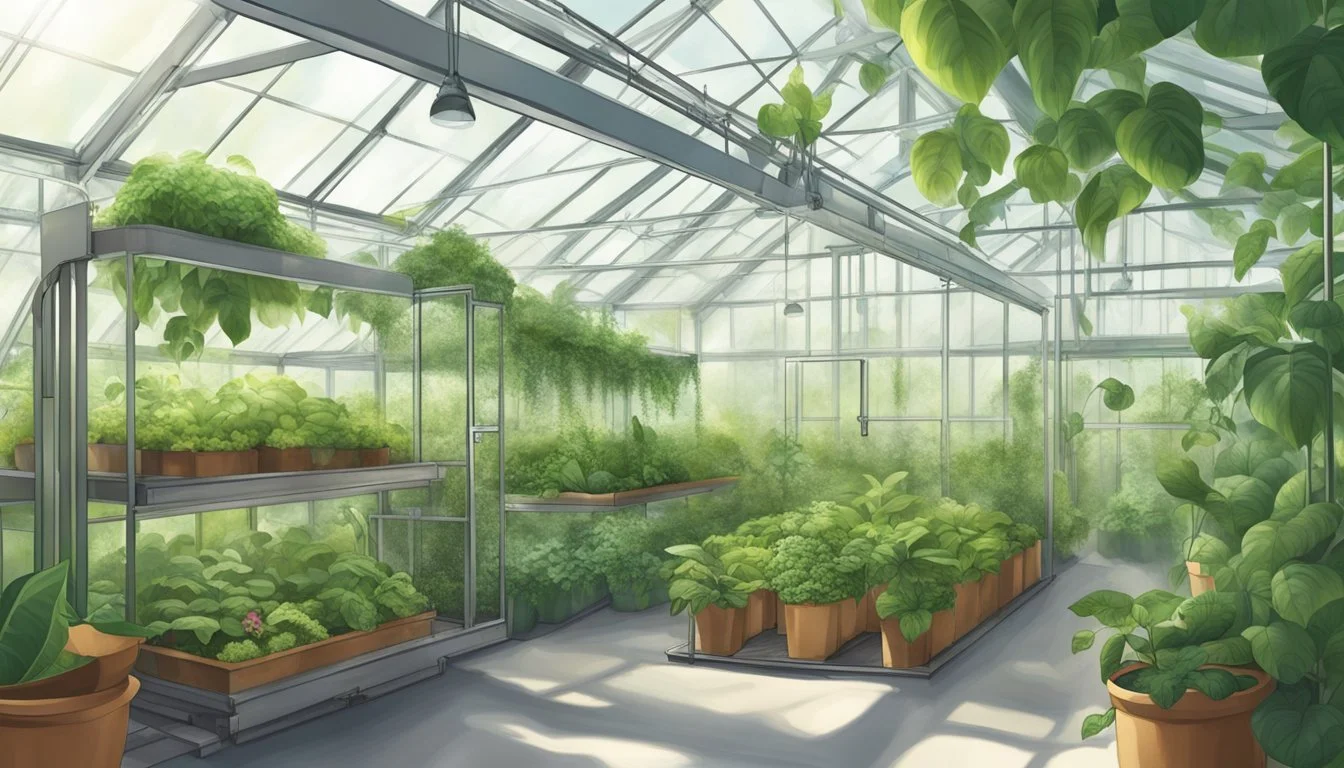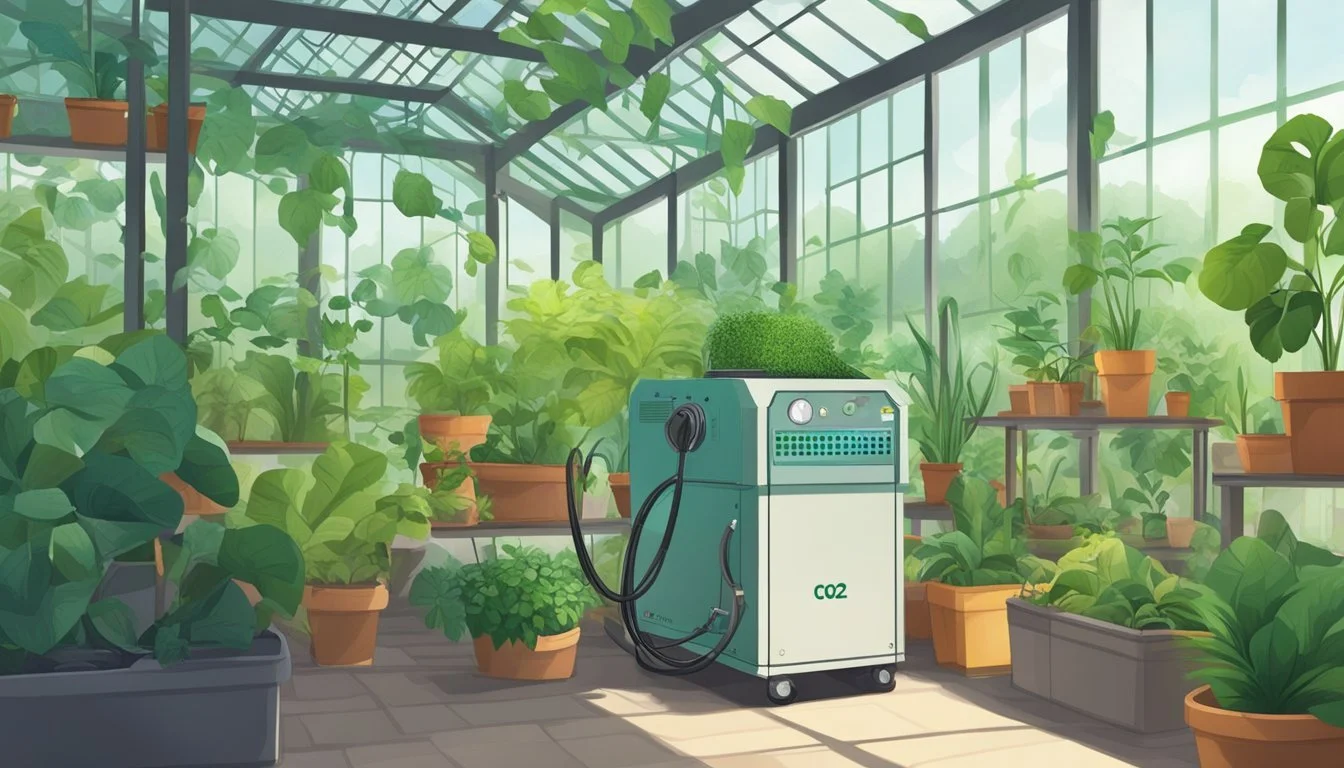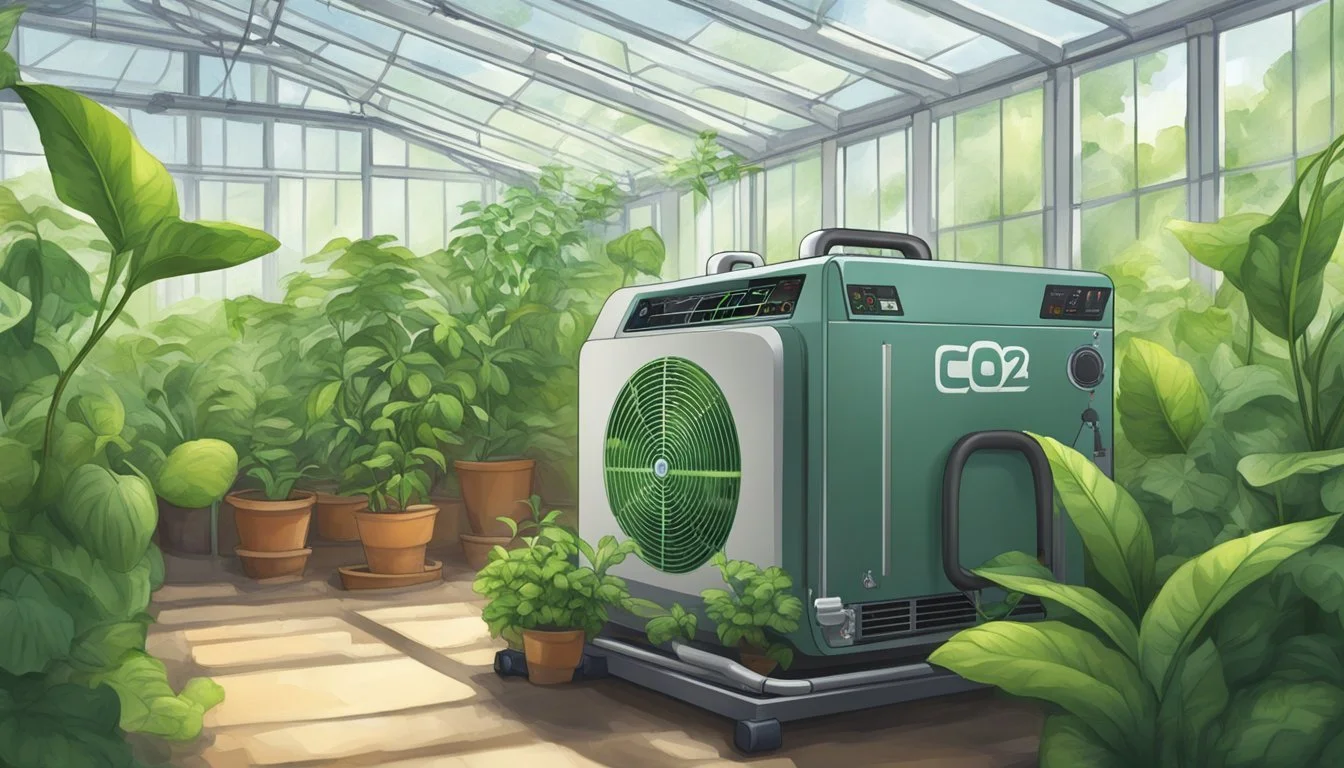How to Use a Portable CO2 Generator for Greenhouse Enrichment
A Homesteader's Guide
Carbon dioxide (CO2) enrichment in greenhouses is a crucial technique for homesteaders aiming to optimize plant growth and increase yield. Plants rely on CO2 for photosynthesis, the process that allows them to convert light energy into chemical energy. In the enclosed environment of a greenhouse, CO2 levels can quickly diminish as plants use it up, limiting their growth potential. To address this, portable CO2 generators are employed, offering a controlled and consistent supply of CO2 that is essential for maintaining optimal levels for photosynthesis.
The use of portable CO2 generators allows for a precise management of the greenhouse atmosphere. Homesteaders can tailor CO2 levels to their specific crop needs, with optimal concentrations typically ranging between 500 and 1500 parts per million (ppm), which is higher than the natural atmospheric CO2 concentration of about 400 ppm. Ensuring the correct CO2 level is a delicate balance; while increased CO2 can significantly enhance plant growth and yield, excessive concentrations can be detrimental to both plants and humans working within the greenhouse.
Homesteaders considering CO2 enrichment should invest in proper monitoring systems to measure CO2 levels and adjust them as necessary. The practice not only requires a sound understanding of the needs of various crops but also necessitates a commitment to safety and equipment maintenance. By integrating CO2 enrichment practices, greenhouse growers can create an environment that pushes their crops towards maximal productivity, a cornerstone goal in the pursuit of efficient and successful homesteading.
Understanding CO2 and Its Importance in Plant Growth
Carbon dioxide (CO2) is a critical component required for the process of photosynthesis, through which plants convert light into chemical energy. Effective CO2 enrichment in greenhouses can significantly enhance plant growth and yields.
The Role of Carbon Dioxide in Photosynthesis
Photosynthesis is the process by which plants use sunlight, water, and CO2 to create glucose, which serves as their energy source. Carbon dioxide acts as a key ingredient in this process, combining with water to form glucose and oxygen. The role of CO2 is thus fundamental to the sustenance of plant life.
Benefits of CO2 Enrichment in Greenhouses
CO2 enrichment within a greenhouse environment is proven to boost plant growth and increase yield. Elevated CO2 levels can enhance photosynthetic rates, leading to more robust plant development. A notable benefit is the potential for faster growth cycles, which can facilitate higher production rates and more bountiful harvests.
Optimal CO2 Concentration for Plant Health
An optimal CO2 concentration is essential for maximum plant health and productivity. Scientific understanding suggests maintaining greenhouse CO2 levels at about 350 to 1,000 parts per million (ppm) for most plant species. It is important to monitor and adjust these levels to align with the specific needs of the crops being cultivated.
CO2 Concentration (ppm):
Plant Response:
150 - 200: Minimum required for growth
350 - 1,000: Ideal range for most plants
Above 1,500: Potential for toxicity
CO2 as a Limiting Factor in Crop Production
CO2 is commonly the limiting factor in crop production, especially in enclosed spaces like greenhouses where natural CO2 concentrations may not be sufficient. Strategic CO2 supplementation can alleviate this constraint, leading to significant improvements in plant growth rates, health, and overall yield.
Types of CO2 Generators for Greenhouse Use
CO2 generators are pivotal for optimizing plant growth in greenhouses. They achieve this by elevating the levels of CO2, which plants utilize during photosynthesis. Here is an overview of the different types available to homesteaders.
CO2 Generators Using Combustion
Combustion-based CO2 generators produce carbon dioxide by burning fuels. These units are highly efficient and can produce a substantial amount of CO2 quickly. Greenhouse operators must ensure adequate ventilation when using combustion-based generators to prevent the buildup of harmful byproducts.
Natural Gas and Propane CO2 Generators
Units that use natural gas or propane are among the most common CO2 generators for greenhouses. Natural gas generators are typically connected to a utility line, while propane generators use refillable tanks. Both types should have a safety system in place to monitor and control the emission levels.
Advantages:
Reliable CO2 production
Adjustable output levels
Considerations:
Installation location
Access to fuel sources
Fermentation and Organic CO2 Generators
These generators utilize natural processes like fermentation to produce CO2. They rely on the decomposition of organic materials by microbes. While slower in CO2 production than fuel-burning models, these generators are a more sustainable option as they can use waste materials as a resource.
Dry Ice as a CO2 Source
Dry ice, which is solid carbon dioxide, can be used as a source of CO2 in greenhouses. When dry ice sublimates, it releases CO2 gas. It's an easy-to-use option, especially for smaller operations, as it does not require any combustion or electricity. Users must handle dry ice with care due to its extremely cold temperature.
Note:
Dry ice placement is crucial for effective distribution of CO2.
Regular replenishment is necessary as dry ice continuously sublimates.
Setting Up a CO2 Enrichment System
Implementing a CO2 enrichment system in a greenhouse setting enhances plant growth and yield. Careful selection and setup of equipment are crucial to a successful CO2 enrichment regime.
Choosing the Right CO2 Generator
Selecting an appropriate CO2 generator depends on the size of the greenhouse and the specific requirements of the plants. Portable CO2 generators are popular for small to medium-sized greenhouses. They come in various sizes and capacities, ensuring there's a match for every need. It is essential to choose a generator that can maintain the desired CO2 levels consistently.
Installation Considerations for Safety and Efficacy
Safety should always be a priority when installing a CO2 generator. The system must be set up to avoid over-concentration of CO2 which can be hazardous to both plant health and human safety. Proper ventilation must be established to prevent the accumulation of CO2 to dangerous levels. Additionally, the generator should be positioned in a manner that ensures even distribution of CO2, preferably above the plant canopy where gas can descend onto the plants evenly.
Sealed Greenhouse Environments
In a sealed greenhouse, it is essential to maintain a controlled atmosphere for optimal plant growth. Sealing the environment helps to contain the CO2, preventing it from escaping and maximizing its usage by plants. It is important to ensure that the greenhouse is as airtight as possible, checking for leaks around doors and walls, to make the CO2 enrichment system efficient.
Using CO2 Regulators and Environmental Controls
Using a CO2 regulator is critical for managing the precise flow of CO2 within the greenhouse. The regulator should be connected to a control device that monitors the parts per million (PPM) of CO2 in the environment and adjusts the output accordingly. Environmental controls are further responsible for maintaining a balance between CO2, temperature, and humidity, aligning them with plant requirements for a successful yield.
Implementing these aspects will ensure the CO2 enrichment system functions at its best, promoting a healthy and productive greenhouse environment.
Operating the CO2 Enrichment System
The effective operation of a CO2 enrichment system within a greenhouse is critical for optimizing plant growth while maintaining a safe environment for both plants and humans.
Creating an Effective Enrichment Schedule
To ensure that the plants receive the CO2 they require without waste, one must establish a schedule. The schedule should align with the plants' natural photosynthesis cycle, typically increasing CO2 delivery during the peak daylight hours when plants photosynthesize and consume more CO2. Off-peak times, such as night when photosynthesis ceases, CO2 supplementation should be reduced or halted to conserve resources.
Maintaining Optimal CO2 Levels
Optimal CO2 levels in a greenhouse typically range between 800 to 1,500 parts per million (ppm), which can significantly enhance plant growth compared to ambient CO2 levels of approximately 400 ppm. One must regularly monitor these levels using a CO2 sensor to ensure they remain within target ranges. Abrupt fluctuations can stress plants, so adjustments to CO2 release from the generator should be gradual and consistent.
Modulating CO2 Based on Plant Growth Stages
Different plant growth stages require varying CO2 concentrations for maximum efficiency. Seedlings and young plants may thrive with lower CO2 levels, whereas flowering and fruiting stages could demand higher concentrations. Adjustments should be made accordingly, gradually increasing the CO2 as the plants mature.
Monitoring for Harmful Gases
While increasing CO2 within the greenhouse, one must be vigilant for the presence of harmful gases that can emerge from combustion-based CO2 generators. This includes gases such as carbon monoxide, ethylene, and nitrogen oxides. Ideally, these should be maintained at negligible levels, as even small amounts can be detrimental to plant health. Regular checks with multi-gas detectors can prevent the accumulation of these pollutants.
Measuring the Impact of CO2 Enrichment
To effectively gauge the impact of CO2 enrichment in a greenhouse setting, one must focus on the precision of CO2 monitoring, examine the resultant changes in plant growth, and assess the subsequent effects on yields and profitability.
CO2 Monitoring and Adjustment
Monitoring CO2 Levels: Consistent CO2 monitoring is critical. Using handheld or stationary CO2 meters, growers should aim to maintain an optimal CO2 concentration around 800 to 1,200 parts per million (ppm) within the greenhouse atmosphere. These levels have been shown to accelerate plant productivity compared to the ambient atmospheric CO2 concentration of approximately 400 ppm.
Adjusting CO2 Supply: Based on continuous readings, CO2 generators must be adjusted to ensure optimal delivery. This involves calibrating sensors to account for fluctuations throughout the day and responding to the plants’ demands effectively.
Analyzing Plant Growth Responses
Observing Growth Rates: The plants' response is a direct indicator of CO2 enrichment efficacy. Enhanced growth rates can be observed and quantified by regularly measuring parameters such as leaf size, stem thickness, and overall vegetative biomass.
Leaf Surface Area: Increased CO2 usually correlates with larger leaf surfaces.
Stem Thickness: Greater stem diameter can indicate better CO2 utilization.
It’s imperative to document these responses over a consistent period to establish a clear connection between CO2 enrichment and growth enhancement.
Impact on Yields and Profitability
Yield Increases: A primary objective of CO2 enrichment is to elevate yield outputs. Plants with access to higher CO2 levels can produce more fruits, flowers, or vegetative mass. This is quantifiable by weighing the harvest from test and control groups within the greenhouse.
Profitability Analysis: Finally, it’s necessary to analyze the cost versus benefits of CO2 enrichment. While higher CO2 levels can boost yields, the financial investment in CO2 generators and monitoring equipment must translate into sufficient profit margins.
Profitable outcomes from CO2 enrichment should reflect a substantial return on investment (ROI) when compared to operational costs.
Yield improvements should be balanced against the expense of CO2 supplementation to justify the approach.
Documenting these figures allows for an informed assessment of CO2 enrichment as a viable strategy for greenhouse management.
Integrating CO2 Enrichment with Other Greenhouse Systems
To optimize plant growth, greenhouse systems must function cohesively. Proper integration of CO2 enrichment with lighting, temperature, humidity, ventilation, and hydroponics systems is critical for creating an ideal growing environment.
Lighting and CO2 Enrichment Synergy
When enhancing CO2 levels, it’s imperative to balance this with sufficient lighting. Plants use CO2 during photosynthesis, and without adequate light, they cannot utilize the extra CO2 efficiently. Optimal light levels vary with the type of plants grown but typically fall within a Photosynthetically Active Radiation (PAR) range of 400 to 700 nm. For homesteaders, pairing LED or HID lights with CO2 generation ensures plants harness the full potential of CO2 enrichment.
Temperature and Humidity Management
Temperature plays a pivotal role in plant metabolism and the efficacy of CO2 enrichment. Ideally, daytime temperatures should range from 22 to 28°C (72 to 82°F), as higher CO2 levels can allow plants to thrive at slightly elevated temperatures. Relative humidity, on the other hand, should be maintained between 40% to 70%, especially when CO2 levels are increased, to support plant transpiration without inviting mold and pathogens.
Airflow and Ventilation Practices
Efficient horizontal airflow is critical to distribute CO2 and maintain uniformity of the enriched environment. Strategically placed fans ensure even CO2 distribution and prevent hot or cold spots within the greenhouse. Proper ventilation systems should be employed to manage excess humidity while maintaining enhanced CO2 levels. Having automated systems that can adjust vents based on real-time environmental data prevents CO2 wastage and ensures a stable greenhouse environment.
Combining Hydroponics with CO2 Enrichment
Hydroponics systems, which supply a water-based, nutrient-rich solution to plants, can be finely tuned to synergize with CO2 enrichment for faster growth. In such systems, ensuring that plants have ample access to nutrients to match the increased growth potential provided by CO2 is crucial. Additionally, adjusting the pH and electrical conductivity (EC) of the solution can help maximize the benefits of a CO2-enriched atmosphere. Hydroponic growers should monitor these parameters closely to align with the accelerated growth rates that elevated CO2 levels promote.
Advanced Techniques and Considerations
When implementing a CO2 generator in a greenhouse, it's vital to consider sophisticated techniques and strategic operations to maximize plant growth while managing resource usage effectively.
Leveraging Biotherm Systems
A biotherm system can significantly enhance the atmospheric conditions within a greenhouse. Such systems use composting biomass to generate heat, and during the process, they also produce CO2 as a byproduct of microbial respiration. Incorporating a biotherm system not only aids in optimizing temperature but can synergistically increase CO2 levels, promoting efficient transpiration and photosynthesis in plants.
Nutrition and CO2 Enrichment
Plants require a careful balance of nutrition, particularly when CO2 enrichment is utilized. Higher concentrations of CO2 can lead to increased growth rates, necessitating a corresponding adjustment in nutrient supply. Operators should ensure that the nutritional inputs—nitrogen, phosphorus, potassium, and trace elements—are commensurate with the enhanced growth potential brought on by CO2 enrichment.
Nitrogen: Vital for leaf and stem growth
Phosphorus: Essential for root development and flowering
Potassium: Important for overall plant health and disease resistance
Greenhouse Operations Planning
Effective planning in greenhouse operations is a cornerstone of utilizing a CO2 generator. Operators must account for daily and seasonal fluctuations in light and temperature, which directly affect plant respiration and CO2 uptake. The integration of a CO2 generator should be mapped out to align with peak photosynthetic activity, ensuring that CO2 enrichment corresponds with the optimal photosynthetic demand of the crops.
Preventing Over-enrichment Issues
Over-enrichment of CO2 can lead to negative outcomes, such as poor crop quality or even toxicity. To prevent these issues, accurate monitoring is essential. CO2 levels typically range from 500 to 1300 ppm for optimal plant growth, and they should not exceed these values. Advanced sensor technology can help maintain these levels by providing precise measurements and controls to adjust the output from the CO2 generator accordingly. It's also crucial to maintain good greenhouse hygiene to avoid the development of harmful compounds from inefficient fuel combustion.








